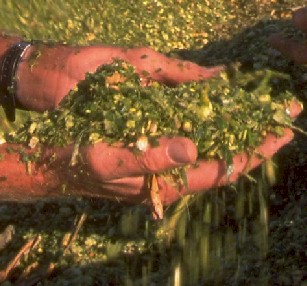Corn Silage
Corn silage is an important source of forage in the United States. It makes up over 40% of the value of the forage fed to dairy cows in the United States and is
also a important feed in the beef finishing industry.
Several characteristics of corn silage make it attractive to many livestock producers. It is a palatable forage with relatively consistent quality and higher yields
and energy content than most other forages. Corn silage production requires significantly less labor and machinery time than other forages because it requires only
a single harvest activity. Hay and haycrop silage, on the other hand, often require multiple harvests. The cost per ton of dry matter also tends to be much lower
for corn silage than for other harvested forage crops.
 Offsetting these benefits of corn silage are
some disadvantages relative to other forages. There are few established markets for silage sales in the Midwest and Northeast, and transportation costs are high
so the crop must often be fed on or near the farm where it is produced. Storage facilities for corn silage also tend to be more expensive than those for dry hay.
However, recently developed alternative storage systems for silage have reduced storage costs to reasonable competitive levels. In some situations, where corn is
not well adapted, the cost of production may be too high to warrant corn silage production. Also, on erodible soils corn silage production may be limited because
of soil conservation requirements.
Offsetting these benefits of corn silage are
some disadvantages relative to other forages. There are few established markets for silage sales in the Midwest and Northeast, and transportation costs are high
so the crop must often be fed on or near the farm where it is produced. Storage facilities for corn silage also tend to be more expensive than those for dry hay.
However, recently developed alternative storage systems for silage have reduced storage costs to reasonable competitive levels. In some situations, where corn is
not well adapted, the cost of production may be too high to warrant corn silage production. Also, on erodible soils corn silage production may be limited because
of soil conservation requirements.
The purpose of this website is to provide the most recent information on cost effective, safe, and environmentally sound ways to produce and use high quality
corn silage. It is largely extracted from the publications below.
Key Resources
- Allen, M., S. Ford, J. Harrison, C. Hunt, J. Lauer, R. Muck, S.
Soderlund. 1995. Corn silage production, management, and feeding. (eds.
G. Roth and D. Undersander). American Society of Agronomy, NCR574, 42
pp.
- University of Wisconsin Corn Hybrid
Trials
- The Relationship between Corn Grain Yield
and Forage Yield: Effect of Moisture, Hybrid and Environment
- Sampling corn silage fields to
accurately determine moisture
- Kernel Milkline: How should we use it for
harvesting silage?
- Corn silage pricing decision aid
- Refereed published articles
- Darby, H.M., and J.G. Lauer. 2002.
Planting
date and hybrid influence on corn forage yield and quality. Agronomy Journal
94:281-289.
- Darby, H.M., and J.G. Lauer. 2002.
Harvest
date and hybrid influence on corn forage yield, quality, and preservation.
Agronomy Journal 94:559-566.
- Cusicanqui, J.A., and J.G. Lauer. 1999.
Plant density and hybrid influence on corn forage yield and quality. Agronomy
Journal 91:911-914.
- Lauer, J.G., J.G. Coors and P.J. Flannery. 2001.
Forage yield and quality of corn cultivars developed in different eras.
Crop Science 41:1449-1455.
- Schwab, E.C., R.D. Shaver, J.G. Lauer, and J.G. Coors. 2003.
Estimating silage energy value and milk yield to rank corn hybrids. Animal
Feed Science and Technology 109(1-4):1-18.